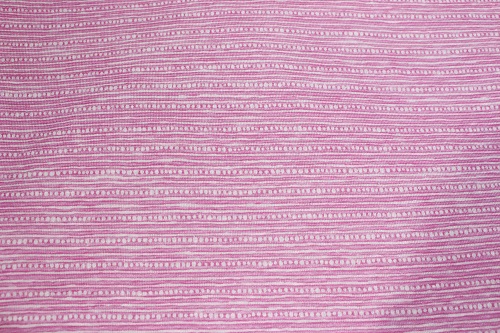0086-18057388688
The Complete Guide to Linen Knit Jersey Fabric: Properties, Production, and Performance
Linen knit jersey fabric is one of the most intriguing textile innovations bridging natural fibers and modern knitting technology. Traditionally, linen is known for its crisp texture, high breathability, and luxurious drape when woven. when transformed into a knit jersey, the result is a fabric that combines the timeless elegance of linen with the elasticity and comfort of knit structures. This synthesis provides a lightweight, breathable, and slightly textured fabric suitable for apparel ranging from summer T-shirts and dresses to high-end casualwear and loungewear.
1. Fiber Composition and Characteristics
1.1 The Linen Fiber
Linen fibers are derived from the flax plant (Linum usitatissimum). The fiber is bast-type, extracted from the inner bark of the flax stem through retting, scutching, and hackling processes.
Key characteristics include:
- High tensile strength: Linen is among the strongest natural fibers, with dry tenacity ranging from 5.5 to 6.5 g/denier.
- Excellent moisture absorbency: Moisture regain averages 12–14%, providing comfort in hot, humid environments.
- Thermal conductivity: Linen efficiently dissipates heat, enhancing breathability.
- Low elasticity: Linen fibers exhibit very low elongation (1–2%), leading to limited recovery but excellent dimensional stability.
1.2 Blends and Combinations
Because linen’s stiffness can be a drawback for knit structures, it is often blended with other fibers to enhance elasticity, softness, and drape.
Common blends include:
- Linen–cotton blends: Improve softness and reduce wrinkling.
- Linen–viscose blends: Increase flexibility and luster.
- Linen–spandex blends (typically 1–5%): Provide stretch and shape retention.
- Linen–polyester blends: Enhance durability and wrinkle resistance.
2. Knit Structure and Construction
2.1 The Jersey Knit
The jersey knit structure is characterized by intermeshing loops of yarn in a single direction (usually the weft). Linen knit jersey is typically produced on circular knitting machines or flatbed knitting machines using fine- to medium-gauge needles.
Key structural features:
- Face side: Exhibits vertical V-shaped knit stitches.
- Back side: Displays horizontal purl loops.
- Stretch behavior: Jersey knits stretch more in the width direction than the length, improving wear comfort.
2.2 Yarn Requirements
Since linen is a stiff and low-elasticity fiber, yarn selection is critical.
To produce a balanced knit:
- Yarn count: Typically Nm 20/1 to 40/1, depending on desired fabric weight.
- Twist level: Moderate twist (500–800 TPM) prevents yarn splitting during knitting.
- Spinning method: Wet spinning is preferred for finer, smoother yarns, while dry spinning yields more textured finishes.
2.3 Technical Adjustments in Knitting
Producing a consistent linen jersey requires addressing several issues:
- Machine speed: Must be reduced (by 10–20%) compared to cotton yarns to prevent yarn breakage.
- Tension control: Precise tension adjustment is essential due to linen’s limited stretch.
- Needle selection: Needles with rounded hooks minimize fiber breakage.
- Lubrication: Light yarn lubrication enhances knitability and reduces linting.
3. Fabric Properties
| Property | Description |
| Weight | 120–220 g/m² (light to medium weight) |
| Drape | Moderate with crisp hand feel |
| Air permeability | Excellent due to open knit structure and linen’s natural breathability |
| Moisture management | High absorbency and quick drying |
| Elasticity | Limited unless blended with spandex |
| Wrinkle tendency | Moderate to high, typical of linen |
| Thermal comfort | Excellent heat dissipation, ideal for warm climates |
| Surface texture | Slightly irregular and slubby, providing a natural aesthetic |
4. Finishing and Processing
The finishing process significantly influences the tactile and visual characteristics of linen knit jersey.
4.1 Scouring and Bleaching
- Objective: Remove natural impurities (pectin, wax, lignin) and achieve uniform whiteness.
- Chemicals: Sodium hydroxide (NaOH) for scouring; hydrogen peroxide (H₂O₂) for bleaching.
- Temperature: Typically 90–95°C to ensure full impurity removal.
4.2 Dyeing
- Preferred dye classes: Reactive dyes (for blends with cotton/viscose) or direct dyes for 100% linen.
- Challenges: Uneven dye uptake due to fiber variability and yarn irregularity.
- Solutions: Cationic pretreatments or enzyme bio-polishing for uniform results.
4.3 Softening and Finishing Treatments
- Mechanical softening: Improves drape and reduces stiffness.
- Enzyme washing: Removes surface fuzz for smoother texture.
- Silicone finishing: Adds subtle elasticity and soft touch.
- Antishrink and wrinkle-resistant finishes: Optional for high-end apparel use.
5. Performance and Durability
Linen knit jersey performs differently from synthetic or cotton jerseys:
- Pilling resistance: Excellent, since linen fibers are long and smooth.
- Abrasion resistance: Moderate; weaker at yarn cross-sections due to low elongation.
- Dimensional stability: Fair, though knit structure may cause slight growth after washing.
- Color fastness: Good with reactive dyes; requires proper fixation.
6. Applications
Linen knit jersey fabric is widely used across fashion, lifestyle, and technical apparel sectors:
- Apparel: T-shirts, tank tops, dresses, cardigans, resort wear, yoga tops.
- Home textiles: Lightweight blankets, cushion covers, decorative throws.
- Luxury segment: Designer collections emphasizing natural texture and sustainability.
- Performance wear (blends): With spandex or polyester for breathability and mobility.
7. Sustainability and Environmental Impact
Linen is among the most sustainable natural fibers due to:
- Low water consumption: Requires significantly less irrigation than cotton.
- Minimal pesticide use: Naturally pest-resistant.
- Biodegradability: 100% biodegradable and compostable.
- By-product utilization: Flax seeds and shives have commercial uses, minimizing waste.
However, challenges persist in the energy-intensive wet processing and chemical dyeing stages.
Sustainable alternatives include:
- Natural dye applications
- Low-impact reactive dyes
- Mechanical softening instead of chemical treatments
8. Care and Maintenance
Linen knit jersey requires careful laundering due to its delicate knit structure:
- Washing: Gentle cycle, cold or lukewarm water.
- Drying: Flat dry to maintain shape; avoid tumble drying.
- Ironing: Low to medium heat while fabric is slightly damp.
- Storage: Fold rather than hang to prevent stretching.
Linen knit jersey fabric is a technical triumph that fuses the natural beauty of linen with the comfort and flexibility of knitwear. Its unique hand feel, breathability, and sustainable profile make it a standout choice for modern consumers and designers seeking both performance and ecological integrity.
































